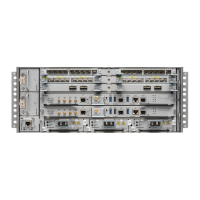Attributes after inbound policy was applied:
next hop:10.0.1.2
MET ORG AS
origin:incomplete neighbor as:3 metric:10
aspath:3
Attributes after outbound policy was applied:
next hop:10.0.1.2
MET ORG AS
origin:incomplete neighbor as:3 metric:333
aspath:2 3
...
Table Policy
The table policy feature in BGP allows you to configure traffic index values on routes as they are installed in
the global routing table. This feature is enabled using the table-policy command and supports the BGP policy
accounting feature.
BGP policy accounting uses traffic indices that are set on BGP routes to track various counters. See the
Implementing Routing Policy on Cisco IOS XR Software module in the Routing Configuration Guide for
Cisco NCS 6000 Series Routers for details on table policy use. See the Cisco Express Forwarding Commands
on Cisco IOS XR Software module in the IP Addresses and Services Command Reference for Cisco NCS
6000 Series Routers for details on BGP policy accounting.
Table policy also provides the ability to drop routes from the RIB based on match criteria. This feature can
be useful in certain applications and should be used with caution as it can easily create a routing ‘black hole’
where BGP advertises routes to neighbors that BGP does not install in its global routing table and forwarding
table.
Import
The import attach point provides control over the import of routes from the global VPN IPv4 table to a
particular VPN routing and forwarding (VRF) instance.
For Layer 3 VPN networks, provider edge (PE) routers learn of VPN IPv4 routes through the Multiprotocol
Internal Border Gateway Protocol (MP-iBGP) from other PE routers and automatically filters out route
announcements that do not contain route targets that match any import route targets of its VRFs.
This automatic route filtering happens without RPL configuration; however, to provide more control over the
import of routes in a VRF, you can configure a VRF import policy.
The following example shows how to perform matches based on a route target extended community and then
sets the next hop. If the route has route target value 10:91, then the next hop is set to 172.16.0.1. If the route
has route target value 11:92, then the next hop is set to 172.16.0.2. If the route has Site-of-Origin (SoO) value
10:111111 or 10:111222, then the route is dropped. All other non-matching routes are dropped.
route-policy bgpvrf_import
if extcommunity rt matches-any (10:91) then
set next-hop 172.16.0.1
elseif extcommunity rt matches-every (11:92) then
set next-hop 172.16.0.2
elseif extcommunity soo matches-any (10:111111, 10:111222) then
pass
endif
end-policy
vrf vrf_import
address-family ipv4 unicast
import route-policy bgpvrf_import
Routing Configuration Guide for Cisco NCS 6000 Series Routers, IOS XR Release 6.4.x
412
Implementing Routing Policy
Table Policy

